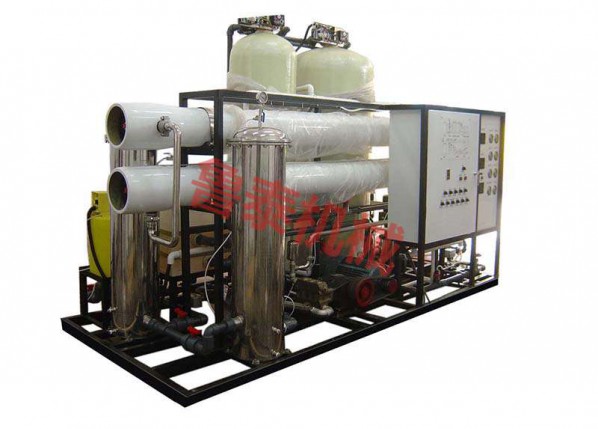1. Seawater Pretreatment
The pretreatment of water supply is the key to ensure the long term stable operation of RO system, whether it is desalination or brackish water desalination. In the preparation of Seawater Pretreatment plan, we should take full account of: there are a lot of microorganisms, bacteria and algae in the sea water. The propagation of bacteria, algae and the growth of microorganisms in the sea water will not only bring a lot of trouble to the water intake facilities, but also directly affect the normal operation of desalination equipment and process pipelines. Periodic high tide and low tide, large amount of sediment in the sea water, turbidity change greatly, and it is easy to cause the sea water pretreatment system to be unstable. The sea water is more corrosive, and the equipment, valves and pipe material used in the system must be screened, and the corrosion resistance is better.
2, seawater sterilization algae
In foreign countries, chemical reagents such as liquid chlorine, NaClO and CuSO4 are used to kill and kill algae. Considering the traffic and other factors, it is difficult to add chemical reagent to kill algae. In this project, the sodium hypochlorite generator is specially used in the process of equipment development. The sea water pump after the separation of a small pressurized water, into the sodium hypochlorite generator to generate NaClO in the DC electric field, face directly into the beach wells, to kill the bacteria in seawater, algae and microorganisms.
Due to the high hardness of sea water, N, aC and lO are produced by direct electrolysis of seawater, and the electrode scaling problem must be overcome. In the process of development, the frequent polarity reversal (EDR) technique of electrodialysis is used, i.e., the electrode polarity is changed once every 5 ~ 10m in, and the precipitation and precipitation of sodium hypochlorite generator is solved effectively.
3 coagulation filtration
Coagulation filtration is designed to remove colloids, suspended impurities, and turbidity in sea water. In reverse osmosis membrane separation engineering, the pollution index (FI) is used to measure the FI value of the feed water of reverse osmosis equipment <4. Because of the large proportion of sea water, high pH value and seasonal variation of water temperature, FeCl3 is used as coagulant in the system. It has the advantages of no temperature, big and strong alum, fast settling speed and so on.
This project adopts the surface contact coagulation filtration technology, composed of double filtration and activated carbon filtration, were set up 2 double deck and 2 sets of mechanical filter, activated carbon filter, filter diameter (m) filter speed between 7 ~ 8m /s. The filter adopts steel coated with glue, marine paint, internal ABS water cap water distribution and 316L stainless steel tube arrangement gas. In order to reduce the Seawater Pretreatment System and the instantaneous load, and to improve the water recovery rate, a reverse flow infiltration system is adopted to filter the backwash water.
3. Reverse osmosis desalination
High salinity, high hardness, corrosion of equipment, water temperature and seasonal variation is called reverse osmosis seawater desalination system than the conventional desalination system is much more complex, project investment and energy consumption are much higher. Therefore, it is very important to reduce the cost of unit water production and ensure the stable operation of the system through careful process design and reasonable equipment allocation to reduce project investment and energy consumption. Marine desalination equipment, large sea water desalination equipment, land desalination equipment
4 ŃĆü chemical regulation treatment
In order to prevent the desalination process due to seawater concentration and formation of insoluble inorganic salts, such as CaCO3, CaSO4, in the reverse osmosis membrane surface system and pieces of pipe fouling in reverse osmosis seawater into the sediment, to add anti fouling agent before desalting system.
Adding H2SO4 to regulate seawater pH and decomposing HCO-3 in sea water to prevent CaCO3 precipitation is a common and economical method in seawater desalination. Adding (NaPO3) 6 (SHMP) is an effective way to prevent the precipitation of CaSO4 (NaPO3), but in 6 scale while producing by-product of phosphate will encourage microbes, bacteria and algae growth, use has some limitations. The high price of special polymer scale inhibitor imported from western countries will directly affect the operation cost of desalination project. In the end of the project, H2SO4 is used as scale inhibitor to control the pH value of the feed water of reverse osmosis system between 6.8 and 7, and to control the water recovery rate of the desalination system to prevent the precipitation of CaSO4.
Considering the reverse osmosis desalination system using composite membrane element with aromatic polyamide membrane material for its poor oxidation resistance in the water requirements of chlorine content in 0.1M g/L following reducing agent off, so in seawater into the membrane system before the addition of NaHSO3, the control of sea water reverse osmosis device before the oxidation reduction potential (ORP). The seawater reverse osmosis device before the oxidation reduction potential (ORP) is 3 times the amount of water in the chlorine dosage in 280 ~ 320mV.NaHSO3.
5 ŃĆü chemical regulation treatment
In order to prevent the desalination process due to seawater concentration and formation of insoluble inorganic salts, such as CaCO3, CaSO4, in the reverse osmosis membrane surface system and pieces of pipe fouling in reverse osmosis seawater into the sediment, to add anti fouling agent before desalting system.
Adding H2SO4 to regulate seawater pH and decomposing HCO-3 in sea water to prevent CaCO3 precipitation is a common and economical method in seawater desalination. Adding (NaPO3) 6 (SHMP) is an effective way to prevent the precipitation of CaSO4 (NaPO3), but in 6 scale while producing by-product of phosphate will encourage microbes, bacteria and algae growth, use has some limitations. The high price of special polymer scale inhibitor imported from western countries will directly affect the operation cost of desalination project. In the end of the project, H2SO4 is used as scale inhibitor to control the pH value of the feed water of reverse osmosis system between 6.8 and 7, and to control the water recovery rate of the desalination system to prevent the precipitation of CaSO4.
Considering the reverse osmosis desalination system using composite membrane element with aromatic polyamide membrane material for its poor oxidation resistance in the water requirements of chlorine content in 0.1M g/L following reducing agent off, so in seawater into the membrane system before the addition of NaHSO3, the control of sea water reverse osmosis device before the oxidation reduction potential (ORP). The seawater reverse osmosis device before the oxidation reduction potential (ORP) is 3 times the amount of water in the chlorine dosage in 280 ~ 320mV.NaHSO3.
6, remove the organic compounds in the sea water and odor
The sea water around the island is greatly affected by the surrounding environment, and the chemical oxygen demand (COD) of the sea water is 1.7 to 2.5m g/L, especially in summer and autumn. Sometimes, the sea water has a large odor. Therefore, in addition to adding NaClO oxidation, an activated carbon filter, the fruit type of granular activated carbon with high mechanical strength can effectively absorb organic matter and stink smell, improve the reverse osmosis water quality, and can reduce the pollution of reverse osmosis membrane surface, prolong the service life of membrane.
7, system control marine desalination equipment, large desalination equipment, land desalination equipment
The reverse osmosis seawater desalination control system design using computer program control at home and abroad, the programmable controller PLC to form a distributed sampling control by IPC operation station, monitor the operation of the centralized control system. According to the process parameters of high and low voltage protection switch, automatic switching device, abnormal conductivity, flow and pressure, can realize automatic switching, automatic interlock alarm, shutdown, to protect the high pressure pump and a reverse osmosis membrane element. Variable frequency control of high pressure pump start and shut down, realize the soft operation of high pressure pump, save energy consumption, prevent water hammer or back pressure caused by high-pressure pump and membrane element damage. The program design before and after the reverse osmosis device can realize low voltage startup and shutdown, automatic flushing, especially in stops, the metastable state of concentrated sea water will precipitate transformation, pollution of membrane surface, low pressure water desalination automatic flushing replacement of concentrated seawater, surface protective film from pollution, prolonging the service life of the membrane. The system temperature, flow, water quality, yield and other related parameters can be displayed, stored, statistical, tabulation and print. Monitor the dynamic process flow in the operation, the picture is clear and intuitive, the system control simplifies manual operation, and ensures that the system can run automatically, safely and reliably.




